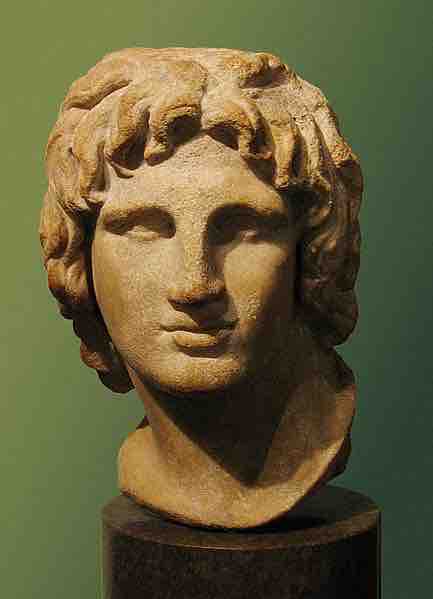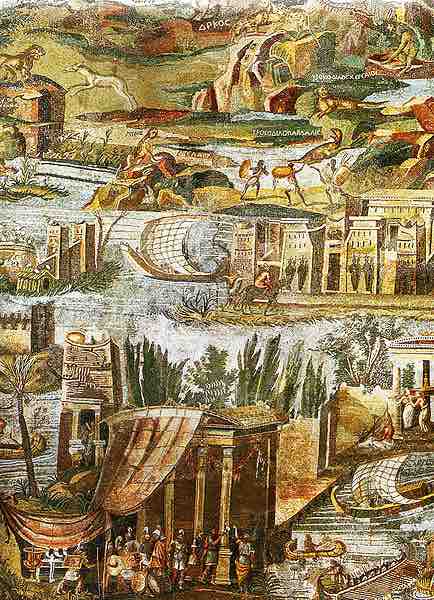The Ptolemaic Kingdom (332–30 BCE) in and around Egypt began following Alexander the Great's conquest in 332 BCE and ended with the death of Cleopatra VII and the Roman conquest in 30 BCE. It was founded when Ptolemy I Soter declared himself Pharaoh of Egypt, creating a powerful Hellenistic state stretching from southern Syria to Cyrene and south to Nubia. Alexandria became the capital city and a center of Greek culture and trade.

Alexander the Great bust
Portrait of Alexander the Great, said to be from Alexandria, Egypt. Marble, second to first century BC.
Hellenistic Art
Hellenistic art is richly diverse in subject matter and in stylistic development. It was created during an age characterized by a strong sense of history. For the first time, there were museums and great libraries, such as those at Alexandria and Pergamon. Hellenistic artists copied and adapted earlier styles, and also made great innovations. Representations of Greek gods took on new forms. The popular image of a nude Aphrodite, for example, reflects the increased secularization of traditional religion. Also prominent in Hellenistic art are representations of Dionysos, the god of wine and legendary conqueror of the East, as well as those of Hermes, the god of commerce. In strikingly tender depictions, Eros, the Greek personification of love, is portrayed as a young child.
Eros Sleeping (Hellenistic, specific date unknown)
Nudity in sculptures of gods like Eros signified an increasing humanization of deities during the Hellenistic era.
Encouraged by the many pharaohs, Greek colonists set up the trading post of Naucratis, which became an important link between the Greek world and Egypt's grain. As Egypt came under foreign domination and decline, the pharaohs depended on the Greeks as mercenaries and even advisers. When the Persians took over Egypt, Naucratis remained an important Greek port, and the colonists were used as mercenaries by both the rebel Egyptian princes and the Persian kings, who later gave them land grants, spreading the Greek culture into the valley of the Nile. When Alexander the Great arrived, he established Alexandria on the site of the Persian fort of Rhakortis. Following Alexander's death, control passed into the hands of the Lagid (Ptolemaic) dynasty; they built Greek cities across their empire and gave land grants across Egypt to the veterans of their many military conflicts. Hellenistic civilization continued to thrive even after Rome annexed Egypt after the battle of Actium and did not decline until the Islamic conquests.

Nile Mosaic of Palestrina (c. 100 BCE)
One significant change in Ptolemaic art is the sudden re-appearance of women, who had been absent since about the Twenty-Sixth Dynasty. This phenomenon was likely due, in part, to the increasing importance of women as rulers and co-regents, as in the case of the series of Cleopatras. Although women were present in artwork, they were shown less realistically than men in the this era, as is evident in a portrait of a Ptolemaic queen (possibly Cleopatra VII) from the first century BCE. Unlike its Classical and Hellenistic counterparts elsewhere in the Hellenic world, this sculpture bears a more stylized appearance.
Sculpture of a Ptolemaic Queen, possibly Cleopatra VII (c. 50–30 BCE)
Despite a growing naturalism among portraits of male elites, those of women remained stylized.
Among male rulers, portraiture assumed a more naturalistic appearance, even when the sitter was pictured in traditional Egyptian regalia, as in a relief of Ptolemy IV Philopator (r. 221–204 BCE), who wears the traditional pharaonic crown of Upper and Lower Egypt. However, even with this Greek influence on art, the notion of the individual portrait still had not supplanted Egyptian artistic norms among non-elites during the Ptolemaic Dynasty.
Ptolemy VI Philometor (c. 186–145 BCE)
In this relief from a ring, Ptolemy VI wears the traditional white and red dual crown of Upper and Lower Egypt while displaying the naturalistic and individualized facial features typical of Classical and Hellenistic portraiture.